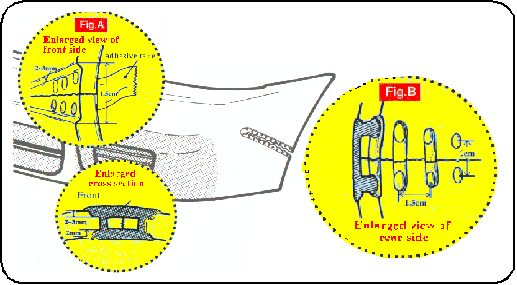PLASTEX is a powder and a liquid. When combined, it actually becomes a plastic. PLASTEX is extremely easy to use and has no mixing ratio. Every PLASTEX kit includes a reusable molding bar which makes it simple to reproduce broken or missing tabs and parts. PLASTEX dries in about 20 minutes, although should sit for 1 hour before being put to use or painted. PLASTEX does not have a shelf life when stored out of direct sunlight and high heat. Also, every PLASTEX kit includes the instructional video cd/dvd which demonstrates all methods of applying PLASTEX.
PLASTEX is excellent for reproducing knobs and other small parts. PLASTEX can also duplicate texture on parts by utilizing the molding bar. PLASTEX works great for repairs on plastic, fiberglass hulls & tubs. Use PLASTEX to restore threads in wood and plastic. Use PLASTEX for hobbies, crafts and models. PLASTEX is great for cell phones, remote controls, and sunglasses. The applications for PLASTEX are almost unlimited.
Below, you will find the different uses and applications for PLASTEX.
FILLING LIQUID APPLICATOR & POWDER DISH/ USING NEEDLE APPLICATION METHOD
LIQUID: Squeeze bulb on pipet, put tip into liquid and release bulb to draw liquid. Move pipet to uncapped applicator bottle and squeeze bulb to transfer the liquid.
POWDER: Remove tip of powder bottle, gently squeeze powder from bottle into dish.
APPLYING PLASTEX USING NEEDLE APPLICATION METHOD
Place the needle on to the top of the applicator bottle. Position above powder dish, gently squeeze liquid bottle, and place two or three drops into powder. Quickly pick up sphere with the tip of the needle and position over repair area. Gently squeeze liquid bottle to flow the material onto the repair area, repeat as needed to complete repair.

USING PLASTEX TO REPAIR CRACKS AND FILL GAPS
Remove any dirt and oil from repair area. File or grind a "V" groove along cracked area. Use packaging tape on front side of repair to keep PLASTEX from seeping through, then use PLASTEX needle method pictured above or use method pictured below. Gently squeeze powder bottle to transfer powder into cracked area, then gently squeeze liquid over powder (make sure powder gets completely saturated). Allow PLASTEX to cure, then sand or paint as desired.

USING PLASTEX TO REPAIR STRIPPED THREADS
Prepare repair area with file, reamer, or drill. Apply a thin coat of spray lubricant or light oil to the screw threads. Apply PLASTEX to threads of screw as needed, place coated screw into stripped out area and allow PLASTEX to cure. Then back screw out and the repair is done.

REPAIRS USING PLASTEX FIBER REINFORCEMENT CLOTH
First, repair crack as instructed above. On the back side, grind away paint 1/2 inch on each side of crack to ensure you are getting to clean bare plastic. Place fiber cloth on a piece of packaging tape and cover with PLASTEX powder. Saturate powder and cloth completely with PLASTEX liquid, then place on repair area. Press firmly onto material to ensure a great bond, then allow to cure. Peel packaging tape off and file or sand if needed.

REPAIRS USING THE PLASTEX REUSABLE MOLDING BAR
Heat molding bar to 120f degrees by placing in hot water, heat gun or hot plate (becomes pliable at 120f). Once bar is warm, form around the object you would like to duplicate and let cool to room temperature. Remove mold and transfer to repair area. Place mold in place and apply PLASTEX mixture as needed. Allow PLASTEX to cure and remove molding bar and your repair area is done.

REPAIRS USING THE STITCHING METHOD
Use this method when the bond is poor (like on dirt bike, ATV, and other flexible plastics commonly made of polypropylene, polyethylene, or other types that won't allow a chemical bond). File or grind a groove along repair area. Drill small holes along both sides of repair. Apply adhesive tape on front of repair to keep the PLASTEX mixture from seeping through (see figure A). Apply PLASTEX along repair and into holes as needed. Allow PLASTEX to cure and remove tape. To connect the holes on the opposite side, grind a groove on the back side of the repair. Apply PLASTEX mixture along repair area (see figure B). Let PLASTEX cure. Sand and apply more PLASTEX as needed.
Use this method when the bond is poor (like on dirt bike, ATV, and other flexible plastics commonly made of polypropylene, polyethylene, or other types that won't allow a chemical bond). File or grind a groove along repair area. Drill small holes along both sides of repair. Apply adhesive tape on front of repair to keep the PLASTEX mixture from seeping through (see figure A). Apply PLASTEX along repair and into holes as needed. Allow PLASTEX to cure and remove tape. To connect the holes on the opposite side, grind a groove on the back side of the repair. Apply PLASTEX mixture along repair area (see figure B). Let PLASTEX cure. Sand and apply more PLASTEX as needed.






